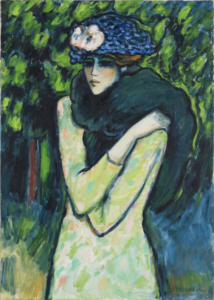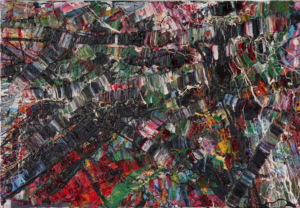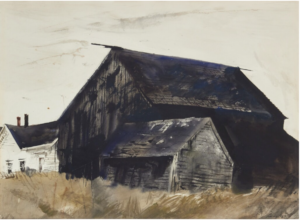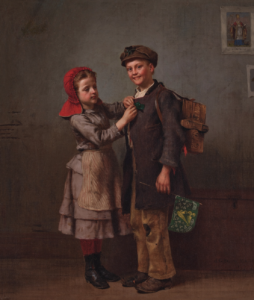
Le renard bleu by Jean-Pierre Cassigneul
On Wednesday, July 17th, Sotheby’s New York hosted an online sale called Modern Discoveries. While online sales are common at major auction houses, it is easy to dismiss them as places where many lower-value pieces get sold. Some see them as an opportunity to sell items that cannot fit into the more prominent sales with actual, living people at the podium. However, Modern Discoveries showed that there are often hidden gems tucked away in these auctions. The sale lasted nearly three hours on Wednesday afternoon, offering one hundred forty-one lots. These consisted mostly of works by European and North American artists like Milton Avery, Maximilien Luce, and Françoise Gilot. The sale’s top lots reflect this makeup. The first one came early on with Jean-Pierre Cassigneul’s Le renard bleu, a 1976 Post-Impressionist-inspired portrait of a woman. The painting has been in the same collection since the artist sold it through Findlay Galleries in Chicago. As well as being the top lot of the sale, the Cassigneul was also one of the sale’s big surprises. Estimated by Sotheby to sell between $40K and $60K, the portrait shot past its estimate range, with the timer running out after the final bid of $140K (or $168K w/p). The Cassigneul seemed to have set an example, as all the top lots at Sotheby’s that day were pieces that exponentially exceeded their high estimates.

Pays by Jean-Paul Riopelle
Though created more than twenty years earlier than the Cassigneul, the second-place lot seems more modern and avant-garde. The 1954 painting Pays by the Canadian artist Jean-Paul Riopelle is one of the “mosaic” paintings that initially made a name for the artist. He created these by using a palette knife instead of a brush, spreading a mixture of paints across the canvas and seeing how it comes out. Riopelle first exhibited his mosaic paintings in Paris in 1953, the year before this work’s creation. This series contributed to the artist’s increasing popularity in Europe, which also led to a more passionate rivalry between the respective abstract art scenes in New York and Paris. Like the Cassigneul, the Riopelle also sold far beyond its estimate range. With Sotheby’s specialists assigning a $40K high estimate, the mosaic painting sold for three times that much at $120K (or $144K w/p).

For Sale by Andrew Wyeth
Finally, two works shared the third place spot: For Sale by Andrew Wyeth is a 1951 watercolor-and-pencil on paper showing what seems to be an abandoned barn likely in Maine. The other was a nineteenth-century painting by the American artist J.G. Brown called St. Patrick’s Day. Brown is renowned among his contemporaries for his attention to detail. In the painting, we see a young shoeshine boy, as indicated by the box on his back. A young girl pins a green ribbon to his coat while he carries a small green flag with a harp and the phrase Erin Go Brach. This is an adaptation of the Irish Gaelic phrase Éirinn go Brách, or “Ireland until the end of time.” The painting is not only an intimate domestic scene between children, presumably siblings, but it shows the significance of the Irish and Irish-American communities in the United States. Though Irish immigration to North America peaked in the 1840s and 1850s, it was still going strong well into the nineteenth century. By the time Brown painted St. Patrick’s Day in 1877, symbols of Irish nationality and Irish pride were more accepted than in decades past. National pride among Irish immigrants and their descendants became incredibly important for the cause of Irish independence from Britain well into the next century. Brown’s paintings have not been particularly popular since the 1990s, with only a few exceptions in recent years. This includes the painting A Thrilling Moment, sold at Christie’s in January 2023 for $650K (or $819K w/p). St. Patrick’s Day is by far the most expensive Brown painting sold since then. Both the Brown and the Wyeth hammered at $110K (or $132K w/p) against respective estimate ranges of $20K to $30K and $60K to $80K.

St. Patrick’s Day by J.G. Brown
The items originally expected to lead the sale included Milton Avery’s painting Artist at the Sea (est. $100K to $150K), Marc Chagall’s pastel Les Fiancés à la chèvre (est. $60K to $80K), and an Andrew Wyeth drawing entitled Archies Corner (est. $60K to $80K). These lots in particular either sold underestimate or were bought in. Other highly-valued lots had mixed results. Had the best performing lots only reached their high estimates, the sale would have failed to bring in the sum initially predicted by the specialists. Though most of the top lots were unexpected surprises themselves, the biggest surprise at Sotheby’s that day came in the middle of the sale. Modern Discoveries featured four works by the fashion designer and heiress Gloria Vanderbilt. While the four had mixed results, few expected the oil painting Women on the Beach to achieve more than its $7K high estimate. It ended up selling for over seven times that amount at $50K (or $60K w/p). It stands out among Vanderbilt’s other work, which normally features a more vibrant color palette.
Of the one hundred forty-one lots available at Sotheby’s on Wednesday, thirty-eight sold within their estimates, giving the specialists a 27% accuracy rate. Unfortunately, many more lots sold below their estimates, adding up to fifty lots (35%). Another twenty-three lots (16%) sold above, while thirty lots (21%) went unsold. Against a total minimum presale estimate of $2.08 million, Sotheby’s Modern Discoveries just managed to sneak by with $2.15 million (or $2.6 million w/p). Even though many lots fell short of expectation, the fact that they sold at all was likely another factor that salvaged the sale in the end.
Sotheby’s NY Modern Discoveries Online Sale
Le renard bleu by Jean-Pierre Cassigneul
On Wednesday, July 17th, Sotheby’s New York hosted an online sale called Modern Discoveries. While online sales are common at major auction houses, it is easy to dismiss them as places where many lower-value pieces get sold. Some see them as an opportunity to sell items that cannot fit into the more prominent sales with actual, living people at the podium. However, Modern Discoveries showed that there are often hidden gems tucked away in these auctions. The sale lasted nearly three hours on Wednesday afternoon, offering one hundred forty-one lots. These consisted mostly of works by European and North American artists like Milton Avery, Maximilien Luce, and Françoise Gilot. The sale’s top lots reflect this makeup. The first one came early on with Jean-Pierre Cassigneul’s Le renard bleu, a 1976 Post-Impressionist-inspired portrait of a woman. The painting has been in the same collection since the artist sold it through Findlay Galleries in Chicago. As well as being the top lot of the sale, the Cassigneul was also one of the sale’s big surprises. Estimated by Sotheby to sell between $40K and $60K, the portrait shot past its estimate range, with the timer running out after the final bid of $140K (or $168K w/p). The Cassigneul seemed to have set an example, as all the top lots at Sotheby’s that day were pieces that exponentially exceeded their high estimates.
Pays by Jean-Paul Riopelle
Though created more than twenty years earlier than the Cassigneul, the second-place lot seems more modern and avant-garde. The 1954 painting Pays by the Canadian artist Jean-Paul Riopelle is one of the “mosaic” paintings that initially made a name for the artist. He created these by using a palette knife instead of a brush, spreading a mixture of paints across the canvas and seeing how it comes out. Riopelle first exhibited his mosaic paintings in Paris in 1953, the year before this work’s creation. This series contributed to the artist’s increasing popularity in Europe, which also led to a more passionate rivalry between the respective abstract art scenes in New York and Paris. Like the Cassigneul, the Riopelle also sold far beyond its estimate range. With Sotheby’s specialists assigning a $40K high estimate, the mosaic painting sold for three times that much at $120K (or $144K w/p).
For Sale by Andrew Wyeth
Finally, two works shared the third place spot: For Sale by Andrew Wyeth is a 1951 watercolor-and-pencil on paper showing what seems to be an abandoned barn likely in Maine. The other was a nineteenth-century painting by the American artist J.G. Brown called St. Patrick’s Day. Brown is renowned among his contemporaries for his attention to detail. In the painting, we see a young shoeshine boy, as indicated by the box on his back. A young girl pins a green ribbon to his coat while he carries a small green flag with a harp and the phrase Erin Go Brach. This is an adaptation of the Irish Gaelic phrase Éirinn go Brách, or “Ireland until the end of time.” The painting is not only an intimate domestic scene between children, presumably siblings, but it shows the significance of the Irish and Irish-American communities in the United States. Though Irish immigration to North America peaked in the 1840s and 1850s, it was still going strong well into the nineteenth century. By the time Brown painted St. Patrick’s Day in 1877, symbols of Irish nationality and Irish pride were more accepted than in decades past. National pride among Irish immigrants and their descendants became incredibly important for the cause of Irish independence from Britain well into the next century. Brown’s paintings have not been particularly popular since the 1990s, with only a few exceptions in recent years. This includes the painting A Thrilling Moment, sold at Christie’s in January 2023 for $650K (or $819K w/p). St. Patrick’s Day is by far the most expensive Brown painting sold since then. Both the Brown and the Wyeth hammered at $110K (or $132K w/p) against respective estimate ranges of $20K to $30K and $60K to $80K.
St. Patrick’s Day by J.G. Brown
The items originally expected to lead the sale included Milton Avery’s painting Artist at the Sea (est. $100K to $150K), Marc Chagall’s pastel Les Fiancés à la chèvre (est. $60K to $80K), and an Andrew Wyeth drawing entitled Archies Corner (est. $60K to $80K). These lots in particular either sold underestimate or were bought in. Other highly-valued lots had mixed results. Had the best performing lots only reached their high estimates, the sale would have failed to bring in the sum initially predicted by the specialists. Though most of the top lots were unexpected surprises themselves, the biggest surprise at Sotheby’s that day came in the middle of the sale. Modern Discoveries featured four works by the fashion designer and heiress Gloria Vanderbilt. While the four had mixed results, few expected the oil painting Women on the Beach to achieve more than its $7K high estimate. It ended up selling for over seven times that amount at $50K (or $60K w/p). It stands out among Vanderbilt’s other work, which normally features a more vibrant color palette.
Of the one hundred forty-one lots available at Sotheby’s on Wednesday, thirty-eight sold within their estimates, giving the specialists a 27% accuracy rate. Unfortunately, many more lots sold below their estimates, adding up to fifty lots (35%). Another twenty-three lots (16%) sold above, while thirty lots (21%) went unsold. Against a total minimum presale estimate of $2.08 million, Sotheby’s Modern Discoveries just managed to sneak by with $2.15 million (or $2.6 million w/p). Even though many lots fell short of expectation, the fact that they sold at all was likely another factor that salvaged the sale in the end.